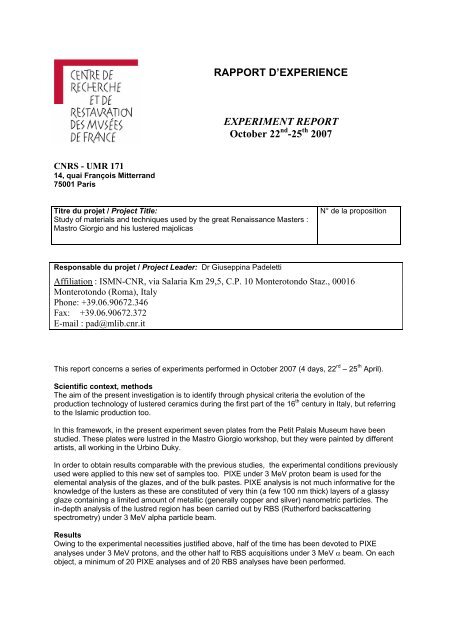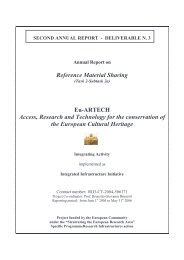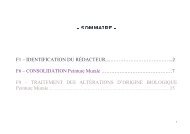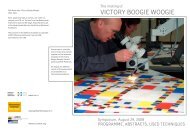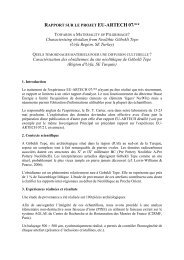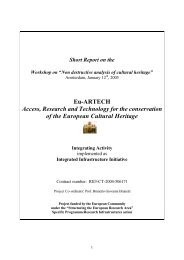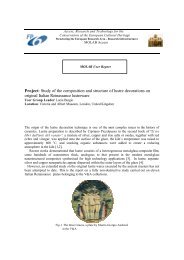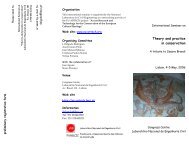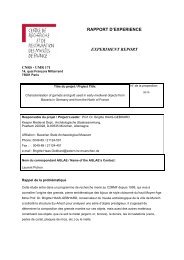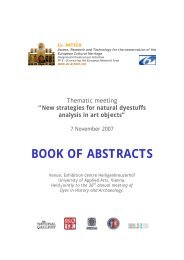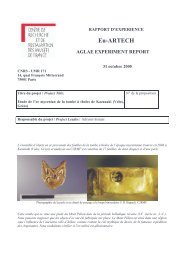User report - Eu-ARTECH
User report - Eu-ARTECH
User report - Eu-ARTECH
You also want an ePaper? Increase the reach of your titles
YUMPU automatically turns print PDFs into web optimized ePapers that Google loves.
CNRS - UMR 171<br />
14, quai François Mitterrand<br />
75001 Paris<br />
RAPPORT D’EXPERIENCE<br />
EXPERIMENT REPORT<br />
October 22 nd -25 th 2007<br />
Titre du projet / Project Title:<br />
Study of materials and techniques used by the great Renaissance Masters :<br />
Mastro Giorgio and his lustered majolicas<br />
Responsable du projet / Project Leader: Dr Giuseppina Padeletti<br />
N° de la proposition<br />
Affiliation : ISMN-CNR, via Salaria Km 29,5, C.P. 10 Monterotondo Staz., 00016<br />
Monterotondo (Roma), Italy<br />
Phone: +39.06.90672.346<br />
Fax: +39.06.90672.372<br />
E-mail : pad@mlib.cnr.it<br />
This <strong>report</strong> concerns a series of experiments performed in October 2007 (4 days, 22 rd – 25 th April).<br />
Scientific context, methods<br />
The aim of the present investigation is to identify through physical criteria the evolution of the<br />
production technology of lustered ceramics during the first part of the 16 th century in Italy, but referring<br />
to the Islamic production too.<br />
In this framework, in the present experiment seven plates from the Petit Palais Museum have been<br />
studied. These plates were lustred in the Mastro Giorgio workshop, but they were painted by different<br />
artists, all working in the Urbino Duky.<br />
In order to obtain results comparable with the previous studies, the experimental conditions previously<br />
used were applied to this new set of samples too. PIXE under 3 MeV proton beam is used for the<br />
elemental analysis of the glazes, and of the bulk pastes. PIXE analysis is not much informative for the<br />
knowledge of the lusters as these are constituted of very thin (a few 100 nm thick) layers of a glassy<br />
glaze containing a limited amount of metallic (generally copper and silver) nanometric particles. The<br />
in-depth analysis of the lustred region has been carried out by RBS (Rutherford backscattering<br />
spectrometry) under 3 MeV alpha particle beam.<br />
Results<br />
Owing to the experimental necessities justified above, half of the time has been devoted to PIXE<br />
analyses under 3 MeV protons, and the other half to RBS acquisitions under 3 MeV α beam. On each<br />
object, a minimum of 20 PIXE analyses and of 20 RBS analyses have been performed.
In the majority of cases, the glazes have been precisely characterised by PIXE, and the different<br />
pigments, blue, green, black, yellow, etc. could be identified.<br />
It was possible to analyse:<br />
- the ceramic body of the objects in some parts;<br />
- the glazes, that are showing common characteristics<br />
- the pigments. On this particular aspect very interesting information have been acquired that<br />
seems to indicate that different painters could use different “palette” . This could be very<br />
interesting, thus permitting the attribution to a painter on a scientific base too (not only<br />
stylistic). A problem arises due to the fact that only 3 or 2 plates for each painter were<br />
observed and this number is not enough to draw a serious conclusion, but we estimate that<br />
this aspect should be carried on.<br />
The RBS spectra are simulated by the SIMNRA code. The layers containing copper and/or silver are<br />
of the order of a few hundred nanometres thick and contain a relatively high amount of metals.<br />
The comparison between those data obtained on the different objects and fragments should provide<br />
enough parameters to identify characteristics of the technological evolution of the workshops all along<br />
the considered period.<br />
The RBS analyses revealed that the lusters present a different and complex succession of layers and<br />
differences in chemical composition, from a plate to another plate. Probably other variables than<br />
datation have to be taken into account in order to explain these variations (different workshops? etc)<br />
This aspect too, in our opinion needs further investigation.<br />
Bibliography<br />
- Padeletti G. and Fermo P. (2003) (invited): How the masters in Umbria, Italy, generated and used<br />
nanoparticles in art fabrication during the Renaissance period, Applied Physics A, 76, p.515-525<br />
- Padeletti G. and Fermo P. (2003): Italian Renaissance and Hispano-Moresque lustre decorated<br />
majolicas : imitation cases of Hispano-Moresque style in central Italy, Applied Physics A 77, p.125-133<br />
- Padeletti G., Fermo P. (2003): Italian Renaissance and Hispano-Moresque luster decorated<br />
majolicas: imitation cases of Hispano-Moresque style in Central Italy, Applied Physics A, 77 (1), 125-<br />
132<br />
- Padeletti G., Fermo P., Gilardoni S., Galli A (2004) : Technological study on ancient ceramics<br />
produced in Casteldurante (central Italy) during Renaissance, Applied Physics A 79, 335-339<br />
- Padeletti G., Fermo P. (2004): Bismuth knowledge during Renaissance strengthened by its use in<br />
Italian lustre production, Applied Physics A 79, 277-281<br />
- Bouquillon A., Padeletti G., Aucouturier M., (2005), Glaze and pigment analyses of Mastro Giorgio<br />
masterpieces; Symposium “Mastro Giorgio da Gubbio. Art, Science and Technology of Lustred<br />
Majolicas”, Gubbio (Italie), 9 th – 11 th November 2005.<br />
- Aucouturier M., Bouquillon A., Roehrs S., Padeletti G., (2005), Luster analysis of Mastro Giorgio<br />
masterpieces; Symposium “Mastro Giorgio da Gubbio. Art, Science and Technology of Lustred<br />
Majolicas”, Gubbio (Italie), 9 th – 11 th November 2005.
- Aucouturier M., Darque-Ceretti E., Hélary D., Chabanne D., (2005), Les céramiques lustrées, de<br />
l’orient islamique à la Renaissance italienne, Symposium “Mastro Giorgio da Gubbio. Art, Science and<br />
Technology of Lustred Majolicas”, Gubbio (Italie), 9 th – 11 th November 2005.<br />
- Giuseppina Padeletti<br />
“Maestro Giorgio da Gubbio”<br />
Ceramics Art and Perspection, 64, 44-45 (2006)<br />
- G. Padeletti, A. Bouquillon, M. Aucouturier<br />
“Bellezza e tecnologia delle maioliche a lustro”<br />
on “Tecniche di analisi di materiali nei Beni Culturali”, 2007 , pag 11-16, Carbone Editore-Palermo<br />
- M. Aucouturier, A. Bouquillon, D. Chabanne, F. Mathis, G. Padeletti<br />
“Application of ion beam techniques for cultural heritage knowledge and conservation”<br />
on “Tecniche di analisi di materiali nei Beni Culturali”, 2007 , pag 3-10, Carbone Editore-Palermo<br />
- Padeletti G. , Ingo G.M., Aucouturier M., Bouquillon A., First-time observation of Mastro Giorgio<br />
masterpieces by means of non-destructive techniques; Applied Physics A 83, (2006), 475<br />
- Chabanne D, Bouquillon A, Aucouturier M., Padeletti G, Physico-chemical analyses of Hispano-<br />
Moresque lustred ceramic: a precursor for Italian majolica?<br />
accepted on Applied Physics A 2008<br />
- G. Padeletti (su invito)<br />
“La Scienza dei Materiali per la Conoscenza e la Conservazione del Patrimonio Culturale”<br />
Dalla Ricerca al Business, 3 Marzo 2008, Catania<br />
- G.M. Ingo, G. Padeletti<br />
“Prospettive di ricerca ed innovazione nelle ceramiche artistiche”<br />
Materiali Ceramici tra Tradizione e Innovazione, Ginori-CNR, 3 Aprile 2008, Sesto Fiorentino<br />
Rome, January 30 th 2008<br />
Giuseppina Padeletti


